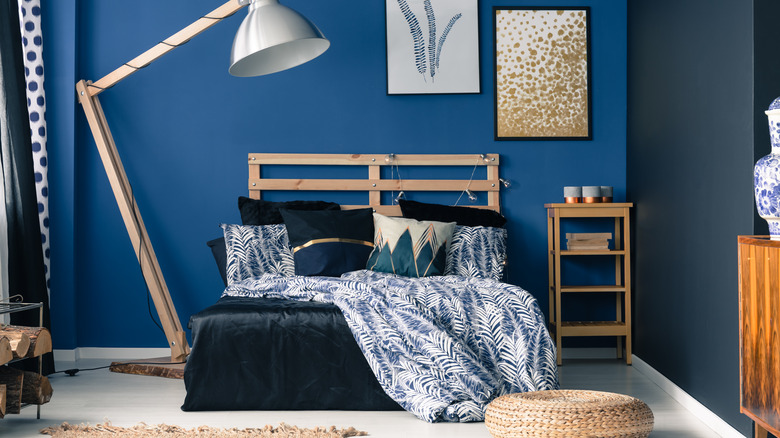The Paint Mistake That Might Be Heating Up Your Bedroom
Your bedroom should be your retreat — a place where you can relax and spend some me-time without the outside world barging in. But your retreat can turn into a heating chamber during the summer season due to one paint mistake. While there's no denying that darker shades in the bedroom look alluring and feel cozy, they can also single-handedly turn the space into an oven. This is because darker colors absorb more heat from sunlight than lighter shades, consequently heating the walls and the whole room. Therefore, while the heating effect does depend on the number of windows in your room, even a few sunny areas could make your room feel like a sauna.
Because dark colors make your room feel warmer, they will also force your air conditioner to work overtime to cool the room. This undue pressure on your cooling system can lead to higher energy bills, effectively burning a hole in your pocket. Additionally, dark-colored furniture and bedding have the same effect and could make it difficult for you to fall asleep in the space.
Why dark colors are a no-go in your bedroom
You shouldn't use dark colors in your bedroom because they absorb much of the sun's light. This light transforms into heat, increasing your room's temperature. To put this into perspective, think of darker shades as sponges; once they've absorbed the light, they turn it into energy and quickly transmit this energy as heat through conduction. While this might not be an issue if you experience cold weather for the better part of the year, a sweltering hot bedroom could become unbearable if you live in hotter regions.
Since colors that absorb more light radiate more heat, it's wise to avoid painting your bedroom in darker shades or adding furniture and bedding in darker tones. Dark colors could include black, deep blue, emerald green, and dark brown. In comparison, choosing lighter and brighter colors like white, light blue, or yellow that reflect more light instead of absorbing it will keep your insides cool and comfortable.
Choosing the ideal paint color for your bedroom
Since darker shades are out, following some best practices will help you pick a lighter shade that matches your bedroom's décor and preferences. The first step is to choose some colors and get their swatches. While paint swatches will give you a rough idea of how your walls will look once you paint them in a particular shade, the exact color will typically look slightly darker on your walls. Because of this, it's a good idea to go with a lighter shade of the color you love.
Alternatively, you can test out some paint shades on your walls to determine how they'll look in your space once dry. Check them out under different lighting conditions and various phases of the day, including morning, noon, and night, to understand how they'll complement your bedroom. However, choose a light color with caution, as shades that are too bright might interfere with your sleep cycle by making your body feel like it should remain awake. To combat this problem, you can cover your bedroom in a neutral paint color.


